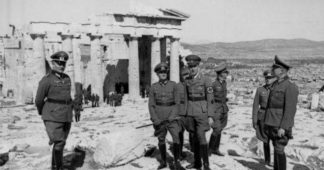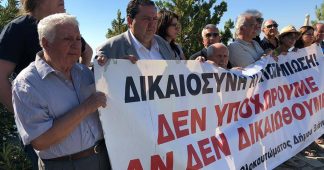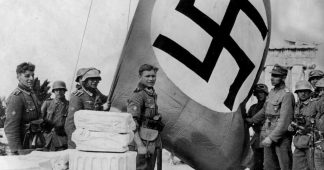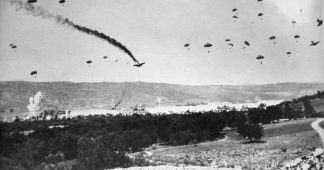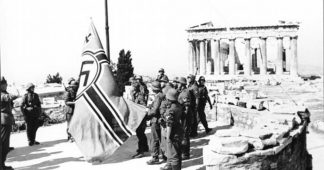Τhe Great Famine (Greek: Μεγάλος Λιμός) was a period of mass starvation during the Axis occupation of Greece, during World War II (1941–1944). The local population suffered greatly during this period, while the Axis Powers initiated a policy of large scale plunder. Moreover, requisitions, together with the Allied blockade of Greece, the ruined state of the country’s infrastructure, and the emergence of a powerful and well-connected black market, resulted in the Great Famine, with the mortality rate reaching a peak during the winter of 1941–42.[3] The great suffering and the pressure of the Greek diaspora eventually forced the British to lift the blockade partially, and from the summer of 1942, the International Red Cross was able to distribute supplies in sufficient quantities; however, the situation remained grim until the end of the occupation.[3]
Contents
Background
Fascist Italy invaded Greece from Albania on 28 October 1940. However, the invasion was quickly turned into a humiliating defeat for the Italians and the Greek forces managed to penetrate deep into Albanian territory. On 6 April 1941, Germany attacked Greece and the Greek forces fell back quickly under the astonishing firepower of the Blitzkrieg. Immediately following their victory, the occupation powers divided the country into 3 zones between which any movement of goods and people was strictly prohibited.[4] The Germans occupied parts of Athens, the region around Thessaloniki, a few strategic outposts in the Aegean and the island of Crete, the Bulgarians held the northern regions of Thrace and Eastern Macedonia, while the Italians controlled most of the mainland and the Ionian Islands.
n general, the Axis powers viewed conquered nations as sources of raw materials, food and labor. As a matter of policy, subjugated nations were to provide material support to Germany and Italy. According to this principle, already from the outset of the occupation, German and Italian troops initiated a policy of wide-scale plunder of everything of value. Moreover, pillage, torture, executions, and civilian massacres throughout Greece were also part of the Axis agenda during the years of occupation. The German attitude toward occupied peoples was expressed succinctly in the words of Hermann Göring in a letter to the Reich commissioners and military commanders of the occupied territories on 6 August 1942:[5]
…This continual concern for the aliens must come to an end once and for all… I could not care less when you say that people under your administration are dying of hunger. Let them perish so long as no German starves.
First months of occupation
Within the occupation zones, the confiscation of fuel and all means of transportation, including fishing boats and pack animals, prevented any transfer of food and other supplies and reduced mobility to a minimum. The occupiers seized strategic industries and appropriated or bought them at low prices, paying with occupation marks they circulated all stocks of commodities like tobacco, olive oil, cotton, and leather and transferred them to their home countries.
Laird Archer, who worked for an American aid agency and was in Athens when the Germans entered the city on 27 April 1941, noted in his Journal:
April 28 … The wholesale looting of Athens has begun.
Remaining food and fuel reserves have been taken first. … [A staff member] found the entire market sealed under the swastika. The Germans have emptied all public [fuel] tanks].… A Marathon farmer, who made his way in today to report that our nurses were safe in the hills, said that his flocks of poultry, even the pigeons, had been machine-gunned and the swastika planted at the four corners of the field. He had been warned to take nothing from the fields on pain of death.
The invaders have been taking meat, cattle and sheep north of the city for some days and now have reserved the dairy herds in the environs of Athens for their own use. … My friends in the Ministry of Agriculture estimate that the 200,000-ton domestic supply may be cut to a third by the slaughtering.
Modern transport has been seized simultaneously with food supplies. Syntagma square is already filled with seized cars. … Buses likewise are being taken. And especially trucks… Orders posted and radioed require all bicycles to be delivered to a given location, More than five thousand have been taken.
Wholesale and retail shops are being systematically cleared out. This is done by the polite method of “purchase” with freshly printed Occupation Marks, of no value outside of Greece. Early this morning, all troops in Athens not on detail were issued with 100 of such marks each. … They were sent into the shops to buy anything from women’s stockings to electrical equipment. They took their “purchases” to the parcel post office or to the reailway express and promptly shipped them home to the Reich… I saw a squad of soldiers, who had cleaned out a small leathergoods shop, carry their new suitcases to a clothing store to be filled. The Eastman Kodak store has been emptied of cameras. … Principal Greek industries are being taken over. This is done by the same polite system of “purchasing” 60 percent of the issued stock and installing a German director.
Raw materials, metal, leather and so on are being confiscated. Scores of little factories, turned back to their owners by the sneering Germans as not of any importance, are without materials for processing. … Carpenters can’t get nails with which to get on with the few construction jobs that are still in progress. Even cement… can no longer be had.
Finally, hospital and drugstore supplies are being taken…
The incredible speed and efficiency of this leaves us dazed, not knowing where to turn for the most ordinary supplies.[6]
Unemployment rose to extreme levels, while extraordinary levies were extorted from the Greek collaborationist government to sustain the occupying forces.[4][7] Occupied Greece was not only burdened with the occupation costs of the German and Italian armies but also with the expenses of Axis military projects in the Eastern Mediterranean. Unlike the rest of the occupied countries, whose costs were limited to their actual defense appropriations prior to the Axis invasion, the size of Greece’s levy in 1941–1942 reached 113.7% of the local national income.[8]
On the other hand, the Allied forces responded with a full naval blockade in order to weaken the Axis in its military efforts. This cut off all imports to Greece, including foods.[4]
Farmers in Greece had to pay a 10% in kind tax on their produce and to sell to the collaborationist government at fixed prices all production above the subsistence level. The food price controls and rationing that had been in place before the Greek defeat were now tightened. With the low government prices and newly imposed taxes, farmers went to great lengths to hide their produce from the officials and traders pulled their merchandise from the shelves, a factor that added to the severing of the foreign trade routes on which Greece traditionally dependeded for food imports.[4] Thus, the scarcity of food supplies resulted in the increase of their prices, while the circulation of the German Occupation Reichsmark and the Italian Casa Mediterranea Drachma led soon to inflation. Under these circumstances, black market and rationing became the only means of food supply in the urban areas of Greece.[9] Fishing was also prohibited, at least during the early period of occupation.[10] Moreover, the Bulgarians forbade any transportation of grain from their zone, where 30% of the Greek pre-war production took place, to the rest of the country.[1]
In mid-September 1941, when the famine was imminent, Berlin responded to enquiries of German officials in Greece:[11]
Supplying Belgium and probably Holland and Norway as well, will be more urgent from the standpoint of military economy than supplying Greece.
Under these conditions, and contrary to the rational exploitation of the national resources applied to the occupied countries in Western and Northern Europe, the Germans in Greece resorted to a policy of plunder.[11] Although the collaborationist government under Georgios Tsolakoglou requested from the Axis to import grain before the winter this didn’t have any serious impact: Germany and Italy sent a very low amount of grain while Bulgaria sent nothing at all. The few organized efforts by the Orthodox Church and Red Cross were unable to meet the needs of the population.[1]
Determining factors of the food crisis were low food availability and curtailment of communications, partly due to the severe lack of transport facilities but especially because it was imposed on both goods and persons. Other factors were the attempt of the local government and the occupying forces to regulate the market and its prices.[12]
Winter of 1941–1942
The nutritional situation became critical in the summer of 1941 and in the fall turned into a full-blown famine.[13] Especially in the first winter of occupation (1941–42) food shortage was acute and famine struck especially in the urban centers of the country.[14] Food shortage reached a climax and a famine was unavoidable.[1] During that winter the mortality rate reached a peak,[12] while according to British historian, Mark Mazower, this was the worst famine the Greeks experienced from ancient times.[14] Bodies of dead persons were secretly abandoned in cemeteries or at the streets (possibly so their ration cards could continue to be used by surviving relatives). In other cases, bodies were found days after the death had taken place.[15] The sight of emaciated dead bodies was commonplace in the streets of Athens.[1][16]
The situation in Athens and the wider area with its port, Piraeus, was out of control, the hyperinflation was in full swing and the price of bread was increased 89-fold from April 1941 to June 1942.[9] According to the records of the German army the mortality rate in Athens alone reached 300 deaths per day during December 1941, while the estimates of the Red Cross were much higher, at 400 deaths while in some days the death toll reached 1,000.[11][17] Apart from the urban areas the population of the islands was also affected by the famine, especially those living in Mykonos, Syros and Chios.[18]
There are no accurate numbers of the famine deaths because civil registration records did not function during the occupation.[19] In general, it is estimated that Greece suffered approximately 300,000 deaths during the Axis occupation as a result of famine and malnutrition.[1][2] However, not all parts of Greece experienced equal levels of food scarcity.[13] Although comprehensive data on regional famine severity does not exist, the available evidence indicates that the severe movement restrictions, the proximity to agricultural production and the level of urbanization were crucial factors of famine mortality.[13]
Lifting of the Allied blockade
Britain was initially reluctant to lift the blockade; however, a compromise was reached to allow shipments of grain to come from the neutral Turkey. The first ship with food supplies that was permitted to reach Greece was the SS Kurtuluş from Turkey, at September 1941. Foodstuffs were collected by a nationwide campaign of Kızılay (Turkish Red Crescent) and the operation was mainly funded by the American Greek War Relief Association and the Hellenic Union of Constantinopolitans.[20] Initially a total of 50,000 tons of food supplies were planned to be shipped from Turkey;[21] however 17,500 tons were able to deliver.[22][23] This assistance remained symbolic since one ship was unable to alleviate such an extreme situation.[24]
Because of the efforts of the Greek Diaspora in the United States and Great Britain, the situation of the starving civilian population in Greece soon became a public issue in the Allied countries. The increasing public pressure finally led to the lifting of the naval blockade in February 1942.[13] The plan carried under the auspices of the International Red Cross, while Sweden offered for the transportation of 15,000 tons of Canadian wheat.[24] Wheat shipments soon began and together with the rising temperatures of springtime, resulted in the reduction of the mortality rates.[13] At the end of 1942 with the steady supply of sufficient quantities to the country’s greatest ports, the mortality rate fell,[17] however the food situation remained grim until the end of the occupation (1944).[25]
The international relief was focused mainly on children. In Athens the Red Cross started to provide daily milk rations, medical services and clothing to children younger than two years. In following March the occupiers and Allied forces agreed to the establishment of the Swedish-run Joint Relief Commission to reorganize the public food supply system. On the other hand, the occupiers moreover committed to replace all appropriated agricultural products with food imports of equal calorific value and relaxed the harshest mobility restrictions and price regulations.[13]
Nazi bailout plan and the resistance
As the collapse of the Greek monetary system was imminent, the Germans were alarmed that such a possibility would render worthless the flow of drachmas to their troops. In order to deal with this situation, Hermann Neubacher, was appointed Reich’s special commissioner in Greece. Neubacher’s objective was to sustain Axis operation in Greece without destroying the Greek economy. His initiative was eased by the supplies provided by the International Red Cross.[26]
From 1943, large areas of the countryside witnessed reprisal operations, burning of settlements and massive executions by the Germans, like in Epirus and Thessaly.[27] The military operations of the Germans against rural areas, from the rising guerrilla activity, sent large numbers of people into the towns or into the mountains, emptying part of the countryside of its labour force. Famine conditions appeared again during the winter of 1943–44 in Aetolia and some islands.[28] Moreover, the rural population did not receive Red Cross supplies like the cities, either because the Germans retaliated against villages suspected of supporting guerrillas or because they feared that the supplies would fall into the hands of the resistance. On the other hand, the largest Greek resistance organization, the National Liberation Front (EAM), took the initiative and distributed food and clothing to the regions it controlled at that time.[29]
Impact on literature and thought
In the everyday Greek language the word “occupation” indicates famine and hunger due to the harsh situation the Greek population faced during these years.[15] Moreover, various works mention the severe situation faced by the Greek population during the years of occupation. One of these is the novel Zorba the Greek, by Nikos Kazantzakis, which reflected the general danger and starvation of that time.[30]
Read more at https://en.wikipedia.org/wiki/Great_Famine_(Greece)
